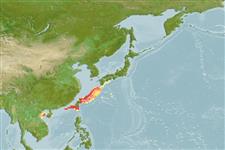>
Anguilliformes (Eels and morays) >
Synaphobranchidae (Cutthroat eels) > Ilyophinae
Etymology: roseni: Named for Donn Eric Rosen.
Eponymy: Dr Giles Willis Mead Jr (1928–2003) was an American zoologist and curator. [...] Dr Donn Eric Rosen (1929–1986) was an American ichthyologist. [...] (Ref. 128868), visit book page.
Environment: milieu / climate zone / depth range / distribution range
Ökologie
seewasser bathydemersal; tiefenbereich ? - 1020 m (Ref. 31449). Deep-water
Northwest Pacific: Taiwan.
Size / Gewicht / Alter
Maturity: Lm ? range ? - ? cm
Max length : 74.5 cm TL Männchen/unbestimmt; (Ref. 31449)
Minimum depth from Ref. 58018.
Life cycle and mating behavior
Geschlechtsreife | Fortpflanzung | Ablaichen | Eier | Fecundity | Larven
Mok, H.-K., C.-Y. Lee and H.-J. Chan, 1991. Meadia roseni, a new synaphobranchid eel from the coast of Taiwan (Anguilloidea: Synaphobranchidae). Bull. Mar. Sci. 48(1):39-45. (Ref. 31449)
IUCN Rote Liste Status (Ref. 130435: Version 2024-1)
Bedrohung für Menschen
Harmless
Nutzung durch Menschen
Tools
Zusatzinformationen
Download XML
Internet Quellen
Estimates based on models
Phylogenetic diversity index (Ref.
82804): PD
50 = 0.7500 [Uniqueness, from 0.5 = low to 2.0 = high].
Bayesian length-weight: a=0.00102 (0.00046 - 0.00225), b=3.06 (2.88 - 3.24), in cm total length, based on all LWR estimates for this body shape (Ref.
93245).
Trophic level (Ref.
69278): 4.0 ±0.4 se; based on size and trophs of closest relatives
Widerstandsfähigkeit (Ref.
120179): niedrig, Verdopplung der Population dauert 4,5 - 14 Jahre. (Assuming tmax>10).
Fishing Vulnerability (Ref.
59153): Moderate to high vulnerability (50 of 100).
